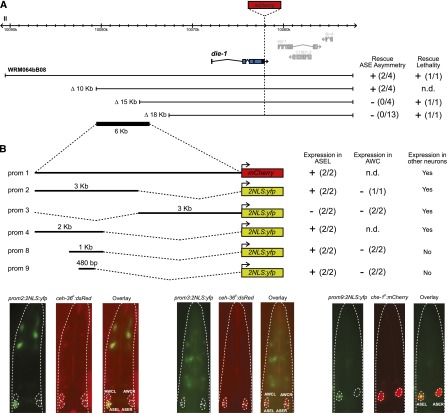Figure 2.
Cis-regulatory analysis of asymmetric die-1 expression in the ASE neurons. (A) Rescue of die-1 fosmid derivatives (representative lines otEx4144, otEx4300, otEx4299, and otEx4342). Each construct was analyzed for its ability to rescue the loss of ASE neuron asymmetry observed in die-1(ot26) as well as the lethality observed in die-1(w34) due to the epidermal enclosure failure. The number of independent lines that showed rescue/number of lines analyzed are shown in parentheses. For the ASE asymmetry scoring, lines considered as providing rescue did so in >80% of the observed animals; lines considered as nonrescuing had 0% of observed animals with the wild-type phenotype. L4 and young adult animals were scored. (B) Defining an ASEL-specific cis-regulatory element in the die-1 locus. The number of independent lines that showed expression/the number of lines analyzed are shown in parentheses. Representative images of larvae carrying three different promoter fusions are shown. die-1prom2 (otEx4349) drives expression in ASEL but not in ASER or the AWC neurons. die-1prom3 (otEx4352) drives expression in a few neurons as well as in some hypodermal cells but not in the ASE or AWC neurons. die-1prom9 drives expression solely in ASEL.

